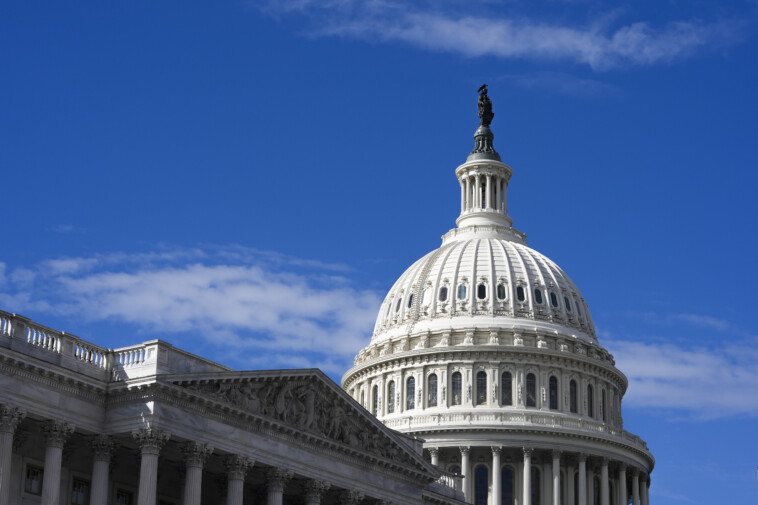House Republicans adopted a blueprint for President Trump’s sweeping legislative agenda package Tuesday night, managing to hold onto their slim majority despite repeated threats from recalcitrant members to derail it.
The framework cleared the House in a 217–215 vote, paving the way for the GOP to unlock the legislative process and begin drafting Trump’s marquee agenda.
Rep. Thomas Massie (R-Ky.) was the sole Republican to oppose the measure during a dramatic voting session that spanned about two hours. At one point, leadership opted to skip over the vote on the blueprint, prompting some lawmakers to leave the chamber, before they were summoned back within 10 minutes.
The blueprint, also known as a budget resolution, features committee assignments to slash $1.5 trillion — and potentially up to $2 trillion — in spending while allowing for $4.5 trillion added to the deficit from tax cuts over 10 years and $300 billion in beefed-up spending for border security and national defense.
“Today, House Republicans moved Congress closer to delivering on President Trump’s full America First agenda — not just parts of it,” Speaker Mike Johnson (R-La.) said in a statement.
“This momentum will grow as we work with our committee chairs and Senate Republicans to determine the best policies within their respective jurisdictions to meet budgetary targets. We have full confidence in their ability to chart the best path forward.”
Just before the budget resolution passed the House, Trump, 78, sounded noncommittal and suggested that he is still open to the Senate Republicans’ dueling proposal. Technically, a president doesn’t sign a budget resolution but the Senate will have input and Trump holds significant sway.
“The House has a bill and the Senate has a bill, and I’m looking at them both, and I’ll make decisions,” Trump told reporters Tuesday, despite personally calling House reps to whip up support.
Given the House GOP’s razor-thin majority and history of internal bickering over basic congressional tasks, Senate Republicans passed their own budget resolution last week.
Their approach would split Trump’s agenda into two tranches — one on border security, energy supply and defense to pass quickly and then a second batch that would deal with taxes.
Johnson, 53, has been adamant that splitting up Trump’s agenda would imperil it in the House because GOP leadership would lose significant and much-needed leverage with hardliners.
The budget resolution is required to unlock the Senate reconciliation process, which is the avenue by which Republicans intend to ultimately pass the final legislation so that they can circumvent a Democratic filibuster.
During the run-up to the Tuesday vote, a handful of hardliners had soured on the blueprint, with Massie being the most vocal critic. Leadership had scheduled the vote on Tuesday but wavered on whether it would actually take place while launching a pressure campaign against members who were on the fence.
“There may be a vote tonight,” Johnson told The Post earlier in the day when asked about the timeline. “There may not be. Stay tuned.”
Massie, 54, told reporters following a House GOP conference confab that, “They convinced me in there. I’m a ‘no.”
Earlier, he had complained that “If the Republican budget passes, the deficit gets worse, not better.”
Johnson downplayed the potential for a deficit increase despite the budget resolution allowing for it, alluding to GOP hopes that tax cuts can spur economic growth and therefore, offset their impact on the deficit.
“The budget resolution itself doesn’t do any of that,” Johnson told The Post about Massie’s complaints. “The objective and our commitment [has] always been deficit neutrality.”
“If we can reduce the deficit even better.”
Start your day with all you need to know
Morning Report delivers the latest news, videos, photos and more.
Thanks for signing up!
The budget resolution was amended to stipulate that if lawmakers who draft the legislation aren’t able to come up with $2 trillion in spending cuts then tax cuts would be pared back.
The framework itself had only given $1.5 trillion in spending reduction assignments to committees. This includes a $880 billion reduction conducted by the House by the Energy and Commerce Committee, a $330 billion by the Education and Workforce Committee and a $230 billion by the Agriculture Committee.
Now that Republicans have overcome the hurdle of getting a budget resolution through the House, the real challenge awaits as they begin to draft the behemoth piece of legislation and delve into specifics.
Republicans are planning to use the package to extend the 2017 Tax Cuts and Jobs Act, which independent estimates have forecasted could increase the deficit by between about $3.5 trillion and $3.9 trillion over the next 10 years.
Then they intend to fulfill Trump’s campaign pledges of eliminating taxes on tips, overtime pay and Social Security.
They have to balance all that with hardliner demands that the final package doesn’t dramatically increase the deficit, which clocked in at $1.8 trillion last year.
Some members, particularly in the Senate also want the tax cuts to be permanent. Due to the rules of Senate reconciliation, provisions must not add to the deficit after 10 years if they are to stay permanent.
If Congress fails to act, key provisions in the 2017 Tax Cuts and Jobs Act are set to expire at the end of the year, meaning that millions of Americans and businesses will face a tax hike.
Johnson has said that his goal is to get the final piece of legislation through the House in April.




